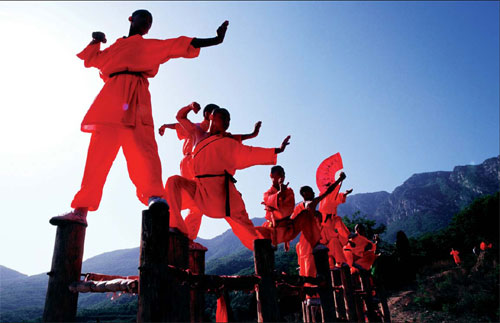Hub of history
Updated: 2012-08-10 07:57
(China Daily)
|
||||||||
|
Travelers can catch a daily kung fu show while visiting Shaolin Temple. Provided to China Daily |
Zhengzhou offers peek into origins of Chinese civilization amid modern development
Shaolin Temple is a mecca for the countless number of Chinese martial arts fans across the globe weaned on popular action movies. But not many know that Zhengzhou, the capital of Henan province where Shaolin is located, offers much more as the hub of a historically and culturally rich area in Central China.
The ancient city was already the capital of the Shang Dynasty (c. 16th century-11th century BC) when porcelain and the Chinese technique of bronze smelting were available.
Zhengzhou is now an economic center and transport hub, with major investments in the agricultural, manufacturing and mining sectors.
But travelers will also find that the city remains a treasure trove of Chinese history and culture, making it a rewarding stop for even short-term visitors.
1. Shaolin Temple

Shaolin Temple was built in AD 495 when an Indian monk Damo, also known as Bodhidharma, arrived to spread Buddhism in China.
The temple has more than 200 towers dating back seven dynasties from the Tang (AD 618-907) to the Qing (1644-1911) dynasties, with one "modern" tower from AD 689 to 1820.
The monastery is considered an ideal spot for a comprehensive study of the history of Chinese architecture, sculpture and religious art.
Fans of Chinese martial arts should catch a 30-minute kung fu show offered daily. Shaolin kung fu is considered the largest system in Han Chinese martial arts, with more than 700 actions and moves. Practitioners believe the essence of the art form reflects the unity between Zen and martial arts. Shaolin monks also practice kung fu as a form of meditation.
2. Songyang Shuyuan
This is one of the four great academies of ancient China built in the Northern Wei Dynasty (AD 386-534).
A 12-sided pagoda in the compound was built in AD 520. Many famous Chinese thinkers lectured in this academy, while emperors also made it an important stop in their inspection tours and sacrificial rites to heaven.
The academy's building is divided into five courtyards and the precise layout of the structures also reflects Confucian thought.
3. Henan Museum
This is one of China's oldest museums. As a major repository of Chinese relics, it boasts modern displays and exhibitions housed in unique architecture.
Henan province, located in the middle reaches of the Yellow River, was called Zhongzhou, or central region, in ancient times. It was an important area in early Chinese civilization.
The museum's exhibits are mostly related to the ancient history and culture of the Henan region, including historical artifacts, buildings, major archaeological discoveries and the arts and crafts of the early Chinese settlers.
4. Yellow River scenic area
This scenic spot is located 30 kilometers northwest of Zhengzhou. It is bounded by the surging Yellow River in the north and Yueshan Mountain in the south, which together help offer some of the most breathtaking views in the region.
Eating and drinking
Zhengzhou cuisine centers on carp and chicken.
There are three famous ways to cook a local carp from the Yellow River: the fish is cut into three pieces, one fillet being fried and one cooked with sweet and sour sauce. The fish head and tail is boiled together with radish slices to make a delicious and nutritious soup.
Famous local dishes also include traditional pastries and translucent noodles.
The best food in town is available from the dense concentration of eating and drinking spots on Jinshui Road.
China Daily
(China Daily 08/10/2012 page22)

 Relief reaches isolated village
Relief reaches isolated village
 Rainfall poses new threats to quake-hit region
Rainfall poses new threats to quake-hit region
 Funerals begin for Boston bombing victims
Funerals begin for Boston bombing victims
 Quake takeaway from China's Air Force
Quake takeaway from China's Air Force
 Obama celebrates young inventors at science fair
Obama celebrates young inventors at science fair
 Earth Day marked around the world
Earth Day marked around the world
 Volunteer team helping students find sense of normalcy
Volunteer team helping students find sense of normalcy
 Ethnic groups quick to join rescue efforts
Ethnic groups quick to join rescue efforts
Most Viewed
Editor's Picks

|

|

|

|

|

|
Today's Top News
Chinese fleet drives out Japan's boats from Diaoyu
Health new priority for quake zone
Inspired by Guan, more Chinese pick up golf
Russia criticizes US reports on human rights
China, ROK criticize visits to shrine
Sino-US shared interests emphasized
China 'aims to share its dream with world'
Chinese president appoints 5 new ambassadors
US Weekly

|

|








